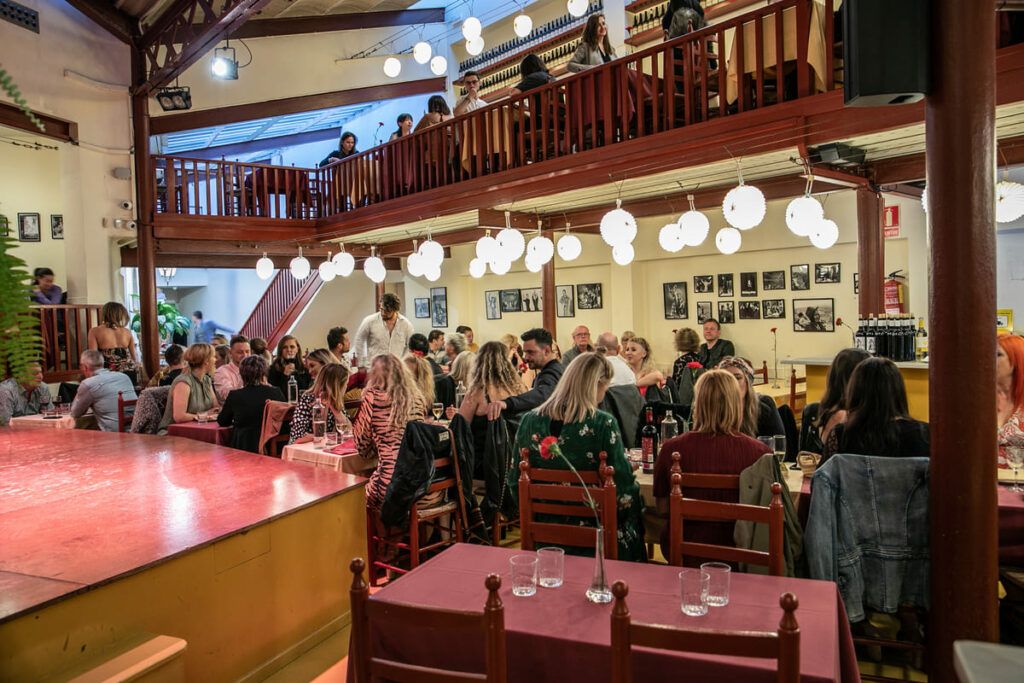Little Spanish language at the tablaos
If you peep into a tablao any day of the week, you will hear people speaking English, French, Italian, Chinese, German or Arabic. Very little Spanish, and mainly spoken by performers and the rest of the employees in the place. If you mention the tablaos in a conversation among Spaniards it is not strange to hear: “But that is for the guiris”. Who cares about watching live flamenco? Are the tablaos full of guiris? Is this something negative?
The public: foreigners, tourists or curious people at flamenco tablaos
Mimo Agüero, the owner and director of the Tablao de Carmen, is aware of the perception many Spaniards have. “For most of the nationals, it is a thing for foreigners without criteria; going to a tablao is not part of the routine for locals, except if you are part of the world of flamenco. The people I know associate flamenco with something exotic”, she explains. When the Tablao was opened in 1988, she says, the idea was that the locals who were keen on flamenco would come, but this was not the case: from the very beginning, the public consisted of foreigners.
In the city, the social dynamic of the 30s when the people from Barcelona filled the cafés cantantes and the tablaos, had already been lost”, explains Mimo. “Guiri” is usually a derogative term. The customers who come here to watch flamenco are tourists, mostly from other countries. I would point out that the tablaos are for curious and anxious people, no matter their nationality or electoral register”.
“Who is the “guiri?”
Ana Pallarés, a veterinary, born in Mallorca and a neighbour of Sabadell for the last six years, has never been to a tablao in Barcelona. “It is not because there are tourists. This is not what prevents me from going, since I would feel even more of a foreigner than any other Spanish person, as I know nothing about flamenco“. Miguel González, an architect, residing in Barcelona for the last four years, has never been there: “Who is the guiri? Because if I, who am from the Basque Country and have never listened to flamenco, and go to a tablao in Seville, that could also be the attitude of a foreigner, somebody who goes and sees for the first time a very special kind of art”. He recognizes that he would trust more in the flamenco art performed at a tablao if it was full of local people, “because you always trust more what the locals choose”. But the reason why neither Ana nor Miguel have never been to a tablao in Barcelona is not the tourists but the price.
High prices, low salaries
“The truth why there are not many nationals at the tablaos, is because the people cannot afford them”, explains Mimo, who admits that he would like to see more Spanish people going to his tablao. The cheapest admission ticket to the Tablao de Carmen, is €48 including one drink; at the Tablao Cordobés (at Las Ramblas) it costs €47, also including one drink; and at Los Tarantos (in Plaza Real), €20 without a drink. Mimo refers to the explanation given by Nino de los Reyes at an interview with Silvia Cruz Lapeña for El País newspaper: “The tablaos are not expensive, the point is that salaries are really low”. Another reason the workers at the Tablao give is that the Spanish do not come just for the fact that they are near: “They do not go to the Sagrada Familia” either, explains Javi, head of the venue, “you do not go because , being so near, you say: ‘well, we’ll go one day’”.
90% of the customers at a Tablao are foreigners.
The high price in proportion to the purchasing capacity in Spain causes that the main profile of the people who attend the Tablaos is the one of those who are ready to indulge in an extra expense, something out of the ordinary either because they take it as a special occasion (a present, for example), or because they are business persons on a business trip. Half of the tablao’s customers are individuals, and the other half are businessmen from outside Spain who are on a business trip to Barcelona and who, through an agency, come in groups to the Tablao, according to Augustin de Beaucé, director of the Tablao de Carmen. 90% of the public at the Tablao de Carmen is from abroad, states Augustin. “But not all tourism is the same”, he explains. “For example, for Ada Colau, tourism is like a drunken uncle along Las Ramblas, and it is necessary to make a difference between the types of tourism. Barcelona attracts high profile tourists and here, to the Tablao, come people who want to know about the culture and are ready to pay. It is highly cultivated people who are keen on music”, he explains.
Flamenco: a contagious form or art
After the passes at the Tablao de Carmen, customers’ cheers and expressions of emotion are very usual being surprised after their first contact with such a special and passionate show that flamenco represents. Lucas Lucero has been a waiter at the Tablao for one hear and a half, and he expresses that it is evident that at first sight they notice that the customers are foreigners. “Everybody comes from different customs and cultures. One of our habitual questions is if they have ever watched flamenco before and the reply by both nationals and foreigners is usually “no”, that that was their first time”, explains Lucas. But he adds that every day he can see how flamenco touches people, wherever they come from, how moving and contagious it is: “When they leave, they go out dancing flamenco or clapping their hands because the energy you feel here is really catchy”.
If you are from Barcelona, we recommend you to visit the Tablao de Carmen at least once in your life. We know that those who do, not only enjoy it, but they leave with the desire to repeat and surprised after the experience of living closely such an art of ours.

